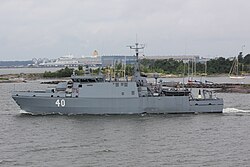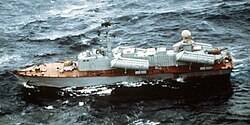Top Qs
Timeline
Chat
Perspective
Algerian National Navy
Military unit From Wikipedia, the free encyclopedia
Remove ads
The Algerian Naval Force (ANF; Arabic: القوات البحرية الجزائرية, French: Forces Navales Algériennes) is the naval branch of the Algerian military. The naval force operates from multiple bases along the country's nearly 1,440 km (890 mi) coastline, fulfilling its primary role of monitoring and defending Algeria's territorial waters against all foreign military or economic intrusion. Additional missions include coast guard and maritime safety missions as well a projection of marine forces (fusiliers marins). Algerian forces are an important player in the Western Mediterranean[citation needed]. The Algerian navy ranks 15th globally in the world's most important naval forces report of 2023.[2][3]
As with other Algerian military branches, the naval force was built and structured with assistance from the Soviet Union during the Cold War, but has also relied on other sources for equipment in some areas[citation needed]. Since the end of the Cold War, Russia has remained an important partner, but Algeria has increasingly sought additional sources for equipment as well as building its own shipbuilding capacity.[citation needed]
Remove ads
Bases
Principal naval bases are located at Algiers, Annaba, Mers el-Kebir, Oran, Jijel and Tamentfoust. Mers el Kébir is home to the OMCN/CNE shipbuilding facilities where several Algerian vessels have been built. Algeria's naval academy at Tamentfoust provides officer training equivalent to that of the army and the air force academies. The naval force also operates a technical training school for its personnel at Tamentfoust.
Remove ads
Equipment
Summarize
Perspective
This section needs additional citations for verification. (April 2025) |
The bulk of the Algerian Naval Force is still based on Cold War designs, although work is being done to both acquire new platforms as well as modernize existing equipment. The surface fleet is equipped with a mixture of smaller ships well suited to coastal and Exclusive Economic Zone (EEZ) patrol work. The fleet is led by three Koni class frigates which have been updated with more modern systems. These are due to be augmented in the coming years by a pair of MEKO A-200 frigates which will represent the most modern equipment of the naval force when they enter service, also, Algeria signed a contract with China Shipbuilding Trading Company for the construction of three light frigates about 2,800 tons full load. A mixture of six corvettes and off-shore patrol vessels complement the frigates, while a large number of smaller boats cover the role of coastal patrol. Algeria had maintained a relatively large fleet of Osa class fast attack craft by the end of the Cold War, but it is questionable whether any of these remain in operational use.
Algeria has had a small submarine presence in the Mediterranean with a pair of Kilo class patrol submarines, Algeria is the only country in the region that can launch offensive missiles from a submarine,[4] though the recent acquisition of an additional four upgraded boats will expand this presence significantly. Their amphibious warfare capacity has traditionally been limited with a small group of landing ships essentially for coastal transport roles. This capacity will be greatly upgraded with the planned acquisition of an amphibious transport dock capable of supporting more robust operations. In the area of civil support, the purchase of seagoing rescue tugs will mark the first ability of an African nation to provide valuable services to economic and commercial operators in the Western Mediterranean.
The Algerian military has long maintained a strong veil of secrecy over its organization and equipment, making an exact accounting of operational vessels difficult to ascertain. Open sources are known to vary widely in their reports of several aspects of Algerian equipment.
Submarines
Amphibious warfare vessels
Surface combatants
Fleet auxiliaries
Aircraft
Modernization

The Naval force is currently being upgraded with the following technological developments: the existing units are being modernized, with the submarine force strengthened by two new Kilo class submarines (last generation).[22]
- One LPD from Italy in 2014.
- Two MEKO A200 frigates from Germany.
- TYPE 054A frigates
- AIP Submarines
- Three corvettes C28A with option of three more produced locally. Radar and electronic equipment will be supplied by Thales, and mounted in Algeria. They will be built at Hudong Zhonghua Shipyard.[23][24][25]
- 31 units of the type FPB98 MKI Ocean Patrol Boat.[26][27]
- 12 units of Alusafe 2000 high speed rescue and patrol vessel.[28]
Remove ads
Munitions
Surface-to-air missiles
- Umkhonto (missile)[29]
- Aster (missile family)[30]
- HQ-7A (FM-90) - on board C28A Class Corvette .
- HQ-10 - on board Type 056 corvette[31]
- 9M33/SA-8 - Osa-M (SA-N-4) naval version for Koni (Mourad Rais) frigate
Anti-ship missiles
- 3M14E or 3M54E1/E Klub-S - Project 636.1 "Improved Kilo"[1]
- 4K51 Rubezh ("Styx") - Coastal defense[32]
- C-802[1]
- C-802A[1]
- CM-302 – Coastal defense; delivered in 2022.[32]
- Kh-31M – 125 delivered in 2009[15]
- Kh-35 - 60 delivered in 2000 and 2013.[15]
- Kh-59 - 125 delivered in 2009.[15]
- P-20U ("Styx")[1]
- RBS-15 Mk. III - Erradii-class frigates[1]
Air-to-ground missiles
- Raptor-2 - Guided bomb from South Africa[33]
Ranks
Commissioned officer ranks
The rank insignia of commissioned officers.
Other ranks
The rank insignia of non-commissioned officers and enlisted personnel.
Remove ads
See also
References
External links
Wikiwand - on
Seamless Wikipedia browsing. On steroids.
Remove ads






































